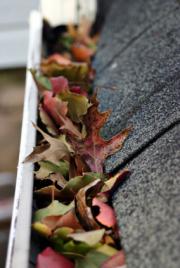Spring is here! That nice bright sun and warm fresh air are a welcome relief from the long, dark winter. Unfortunately, springs arrival means that your home is in need of a little spring cleaning.
Over time the value of your home appreciates, so you should treat it with as much care as possible. Homes change and move over the seasons. After the winter everything from the roof to your sump pump will need to be examined. Spring is the best time to give our home the “tune- up” it needs.
Here is a checklist to help you target the areas that need maintenance so you can get those chores done quickly. Following these simple tips will get you outside and in that warm spring sunshine in no time.
- Inspect brickwork and stucco. Check for chipping, deteriorated mortar and unsightly deposits.
– Spalling is a chipping or popping away of a brick’s face, leaving the brick’s interior susceptible to moisture and crumbling. Any deteriorated mortar should be assessed immediately before more damage occurs.
– Efflorescence is a plaguing of the brick resulting in unsightly white deposits caused by soluble salts left behind during water evaporation. If efflorescence is found, removal is best recommended by dry brushing in warm dry weather.
– If you discover water penetration in the brick, consider sealing the brick surface with an appropriate sealant.
- Replace rotting siding and trim; paint as needed. Hire a professional to tackle siding maintenance.
– Brighten up your home with a good power washing. This will give your home a fresh look and may also show damaged areas that were hidden behind the grime of winter weather.
– If painting is needed, be sure to tackle the whole project. Don’t treat sections and move on. Leaving any wood exposed could lead to the surface rotting. Make sure the whole surface is done to ensure proper resurfacing and color consistency to your home. Be sure to sand the surface and prime any bare wood before painting with a high quality product.
- Clean gutters and downspouts. Multiple freezes and thaws can result in sags and dips.
– Make sure gutters and downspouts direct water away from the home. improper drainage can lead to water in the basement or crawl space. They should point at least two to two and a half feet away from any foundation wall.
– Check that they are flush to the roof with no sags or dips.
– If you live in a two story home, a professional cleaning is recommended. Do-it-yourselfers will be safer cleaning a ranch style home.
– Consider installing gutter guards to protect them from environmental debris.
- Inspect your roof. Check for damaged shingles, which can make your roof susceptible to leaks.
– Shingles that curl up (turn up) and claw (turn down) can make your roof inefficient and susceptible to leaks.
– Shingles that are cracked, buckled or loose or are missing granules need to be replaced.
– Flashing around plumbing vents, skylights and chimneys need to be checked and repaired by a qualified roofer.
– Pooling or ponds of water that fail to drain from flat roofs may indicate low areas of inadequate drainage.
– Call a minimum of three roofers before committing to one for repairs. You will educate yourself in the process and end up with a better deal in the end.
- Get a chimney check- up. Hire a pro that can quickly check for cracks or leaks.
– Have the flue cleaned and inspected by a certified chimney sweep. This includes any active or decorative chimney.
– A professional should also check the chimney flue and cap for cracks or leaking.
- Prune landscaping and create good drainage. Maintain your plants and shrubs to prevent soil erosion.
– Landscaping helps against soil erosion, but should be planted to form a negative grade, which means wiater will flow away from the house.
– Trim overgrown trees and hedges away from your home to discourage the growth of mildew and moisture. Branches should be a minimum of seven feet away from the exterior of your home to prolong the life of your siding and roof.
– Remove out of control vines,as they can help crack siding and allow moisture and pests entry into your home.
– Check for low areas in the yard or next to the foundation. If any are present they should be filled with compacted soil. Spring rains can cause yard flooding, which can lead to foundation flooding and damage.
- Give concrete a little TLC. Seal your driveway, power wash your patio and have a professional service your pool.
– Inspect concrete slabs for signs of cracks or movement. All exterior slabs, with the exception of pool decks, should drain away from the home’s foundation.
– Seal and inspect asphalt or concrete driveways. This is usually done in the fall, but spring is an ideal time to seal them.
– Power wash concrete patios; inspect decks for rotting wood and secure railings. Seal if necessary.
- Check outside hose faucets for freeze damage. Take a peek at your home plumbing.
– Turn the water on and place your thumb or finger over the opening. If you can stop the flow of water, it is likely that the pipe inside the home is damaged and will need to be replaced.
– Check any garden hoses for dry rot, replace if necessary.
– Anything dripping in your home is a bad sign. Check for leaking faucets or sweating pipes, clogged drains and faulty water drainage systems.
– Look at washing machine hoses for bulges, cracks or dampness.
– Check under the kitchen sink for leaks, and make note of wetness around the dishwasher.
– Check the shutoff valve at each plumbing fixture to make sure they are functioning properly. Know the location of all valves and what equipment and water lines they serve. Teach all members of the household of their locations.
- Inspect the water heater.
– If you have a gas- fired water heater, make sure it is venting properly. Light a match next to the vent and wave it out (don’t blow it out). See if the smoke is pulled up into the vent. If it isn’t, have a professional inspect and repair it. Otherwise, carbon monoxide and other combustibles can build up in your home.
– Check around the base of your water heater for evidence of leaks. If your water heater is over five years old, it should be checked monthly for any leakage or rusting at the bottom. If evidence of a leakage or rust is found, the water heater should be replaced.
- Don’t overlook your attic. Check for proper ventilation, obstructions and leaks.
– Check your attic fro proper ventilation and birds nests.
– Look for obstructions over vents, damaged soffit panels, roof flashing leaks and wet spots on insulation.
– Be sure to wear long sleeves and gloves to protect yourself from insulation when checking the attic.
- Check out your heat/ air unit; change batteries in detectors. Change filters and clean the air purifier, but leave the rest to the pros.
– Have your ducts professionally cleaned. It will make your indoor air quality healthier and your furnace more efficient.
– Have a professional clean and service the outside unit of the air conditioning system. Clean coils operate more efficiently, and an annual service call will keep the system working at peak performance levels. An efficient air conditioner removes moisture and humidity from your home, which in excess, can damage its foundation.
– Change air filters on a monthly basis. Some are reusable and are supposed to be taken out, washed with a hose and re- inserted. A unit free of dust and dirt runs more efficiently, saving you time and money on your energy bill.
– Check the hose connections for leaks and any algae blockage. Make sure the drain pans are draining freely. If you suspect a problem, contact a certified technician.
– Clean the outside condensing unit screen of leaves.
– Listen for any unusual noises. This may be your first indication of a problem.
- Check your electrical system. Only a qualified electrician should remove the front panel cover.
– Look for burn marks at the main electrical panel; they can be a sign of arcing inside the panel, which can easily lead to a fire.
– Trip and reset the circuit breakers regularly.
– Remove any combustible materials such as paper boxes or flammable liquids from the area near the main electrical panel. Sparks caused by arching can ignite any material stored nearby.
– Check all electrical outlets for loose- fitting plugs. This is an indication of worn out receptacles, and should be replaced as they cause overheating and fires.
– Check all electrical outlet switches to be sure they are working properly. If there are any that are not working properly, have a qualified electrician determine the problem and fix it to avoid any fires inside the walls of your home.
– Install safety covers to help protect children from electrical shock.
– Unplug any appliance or tool that gives off even the slightest shock. Take to a qualified electrician or repair shop to be checked.
- Clean the kitchen exhaust hood and air filter.
– Keeping this clean of cooking grease will help keep a stovetop fire from spreading.
- Tackle those kitchen/ bathroom tiles.
– Pay attention to the grout between floor tiles in the bathroom or kitchen. A small crack in the grout or caulk can lead to an expensive repair in the future.
– Get in the habit of wiping down the shower walls and tub after each use to eliminate soap and scum build- up.
- Don’t forget about the sump pump.
– Make sure the sump pump is operating correctly. To ensure that it is always in proper working order, install a battery back up pump. If your sump pump does fail, you will not know until it is too late. If your sump pump fails, an alarm goes off, letting you know the backup is working. A few hundred dollars now will save you from thousands later, especially if you have a finished basement.
Preventive maintenance is crucial to the value of your home. Keep your place in tip- top shape with regular check- ups to save you the headache and cost of emergency repairs. It’s the inspections you make in between that really matter.
 Buried irrigation lines can freeze, leaving you with burst pipes and broken sprinkler heads. A few simple steps can save you some spring time Irrigation Irritation.
Buried irrigation lines can freeze, leaving you with burst pipes and broken sprinkler heads. A few simple steps can save you some spring time Irrigation Irritation.
 Lubricate locks and hinges: Creaky hinges and sticking locks can spook you at exactly the wrong moment, so make the rounds with a can of WD-40. It’ll clean and lubricate metal mechanisms in one shot.
Lubricate locks and hinges: Creaky hinges and sticking locks can spook you at exactly the wrong moment, so make the rounds with a can of WD-40. It’ll clean and lubricate metal mechanisms in one shot. Quiet kitchen cabinets: Before the Fall is over, your kitchen will soon be bustling with holiday dinners, baking projects, and house guests, so don’t let little annoyances get in the way of big plans. Clean and lubricate drawers and hinges on kitchen cabinets, and replace any catches that no longer catch.
Quiet kitchen cabinets: Before the Fall is over, your kitchen will soon be bustling with holiday dinners, baking projects, and house guests, so don’t let little annoyances get in the way of big plans. Clean and lubricate drawers and hinges on kitchen cabinets, and replace any catches that no longer catch.